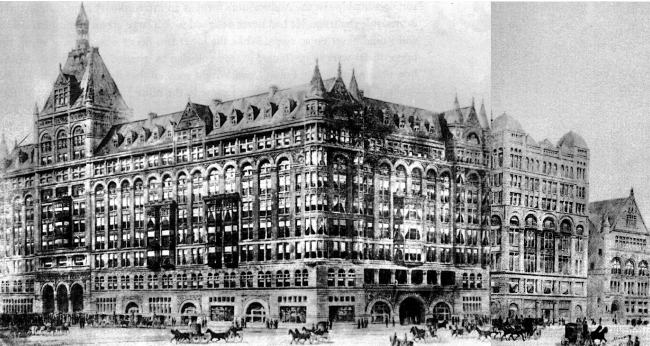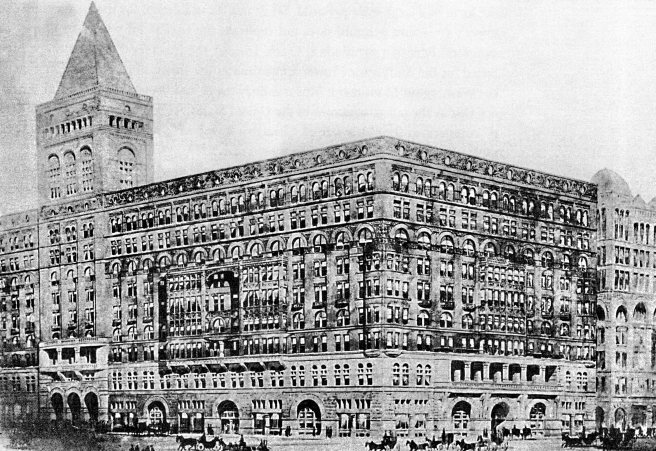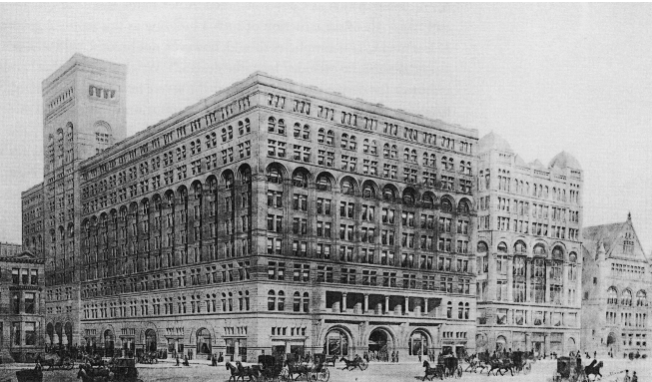
1910-1920
First Drafts
Dankmar Adler and Louis Sullivan were appointed as the Auditorium Building’s architects on December 22, 1886. However, the pair had been creating studies for months prior to their hire. The earliest known design of the Auditorium Theatre was prepared by September 1886, soon after Ferdinand Peck hand obtained control of the parcels of land the building sits on. The architectural renderer Paul C. Lautrup prepared the first design of the Auditorium and the ones that followed as they evolved. Lautrup also prepared a smaller rendering which Peck carried around the city in his pocket to help with fundraising.[1] The pointed roofs and ornate design of the exterior from the first rendering is far off from the final product, but suggests that this style was Sullivan’s initial preferences. The plans for this study were to have the lower two floors made of stone and the upper floors out of more stone, pressed brick, terracotta, and iron.

At the board’s meeting of December 11, 1886, a revised design of the exterior was presented. It was decided that the first design “was too frivolous or ornate” and “should be more of a monumental character.”[2] Its foundation of a two-story stone base, five-story arcade, and eight-story attic remained the same, but the pitched roof was replaced with a flat top. This new iteration of the Auditorium’s exterior is much closer to the current building, but was still heavily decorated with ornaments, especially along the top trim of the crown. The most notable feature of this design was the tower and the pyramid-like shape that sat on top. The rendering of this exterior brought the comment, “Stability and massiveness are apparent in all its parts, as if intended to be carried down the centuries like an Egyptian pyramid.” The Auditorium’s allusion to the Egyptian monuments didn’t stop there. One local writer said, “In a democracy, Ferdinand W. Peck has been a Pharaoh, building like Cheops; if you enter Chicago from the south, you saw the spike among the nails.”[3] Locally Chicagoans compared this local monument to Egyptian hypostyle halls, whose architecture had advanced “to a high degree of perfection.”

Ultimately, the pyramid crown was removed per the suggestion of Professor William Ware, founder and head of Columbia University’s School of Architecture and former head of the first academic School of Architecture at Massachusetts Institute of Technology. The beginnings of Professor Ware’s involvement with the Auditorium are unclear but he was Sullivan’s principal teacher during his one-year at the Massachusetts Institute of Technology. Professor Ware’s reputation was highly recognized and so despite his brief participation in the building’s planning, it was his opinion that determined the building’s final form. Before leaving Chicago, Professor Ware said, “the new Auditorium would command more of a national attention and reputation than any building ever built in this country.”[4] After the Auditorium’s completion, Dankmar Adler described the exterior as “dignified, impressive, simple and straightforward.”[5]

Theodore Roosevelt
Theodore Roosevelt is nominated for President of the United States at the Auditorium Theatre by the National Progressive Party, Bull Moose Party, in 1912. On our stage, Roosevelt gave his famous “Armageddon” speech:
“… the time is ripe, and overripe, for a genuine Progressive movement, nationwide and justice-loving, sprung from and responsible to the people themselves … representing all that is best in the hopes, beliefs, and aspirations of the plain people who make up the immense majority,”
Woman’s Suffrage
In June 1916, Chicago hosted the Republican National Convention, which became a chance for the Congressional Union for Woman Suffrage (CU) and the National American Woman Suffrage Association (NAWSA) to campaign and gather support from U.S. leaders. During this event, the Auditorium Theatre provided an opportunity for women’s suffrage organizations to assemble and host speeches to advocate for the advancement of women’s voting rights. The CU hosted the Suffrage First Luncheon at the Auditorium and at this meeting CU leaders proposed the adoption of the Susan B. Anthony Amendment, which states that voting rights for U.S. citizens could not be denied “on account of sex.”
[1] “Chicago Real Estate: Subscribers to the Grand Opera Hall,” Chicago Tribune, 26 September 1886, 7.
[2] Mueller, Testimony, Chicago Auditorium Association vs. Mark Skinner Willing, in Kaufmann, “Wright’s ‘Lieber Meister,’” 49.
[3] John McGovern, quoted in Ffrench, Music and Musicians in Chicago, 32.
[4] “Seats for a Multitude,” Chicago Evening Journal, 29 January 1887, 1.
[5] Siry, Joseph. The Chicago Auditorium Building : Adler and Sullivan’s Architecture and the City. Chicago: University of Chicago Press, 2002. Print.
